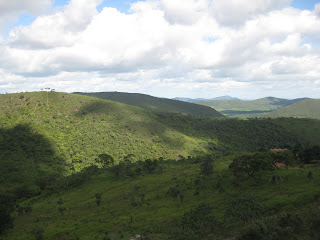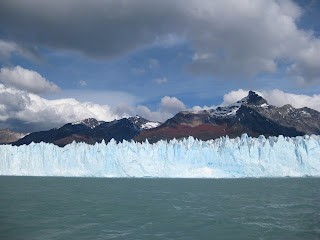My journey to Campo Formoso, Bahia, began at 8am, sleepily boarding a bus to Salvador. Thankfully I had my lovely friend Fernanda to help me to get my luggage there and sort out the formalities, I don't know how I would have coped without her! As was the case in Argentina, the long-distance buses in Brazil are really quite good - very comfortable seats which recline most of the way back, and regular stops to get food (or smoke a cigarette!), although they do insist upon over-air-conditioning to the point where I was actually far too cold most of the way. The other less comfortable aspect was the on board video. After about half an hour of traveling, they put on Legally blonde 2, badly dubbed into Portuguese. I was so tired that I didn't mind too much because I was able to sleep through it, but when it finished, they let the title soundtrack play on repeat for about 10 minutes before finally pressing play, and making us watch it again. If this is their idea of entertainment, frankly I'd rather be bored!
But if I thought this was bad, it was about to get much worse. I arrived in Salvador feeling pretty good, I'd managed to sleep through Legally blonde 2, twice, and felt quite refreshed from my sleep. But Salvador was about 5 degrees hotter than Aracaju, and more humid, and as I entered the bus station I realised that everyone in Brazil was also trying to travel today. I was the thursday before Easter, a holiday in Brazil, and the station was absolutely teeming with people. Every available patch of ground had a hot Brazilian person sitting on it, and with all my luggage, just trying to navigate as far as the bus company to buy my next ticket was quite an ordeal. When I found out I was going to have to wait here for 4 hours for the next available bus to Senhora de Bomfim, I was just about ready to kill someone. Thankfully for everyone concerned, I managed to find a place to store my luggage, which just about appeased me sufficiently to prevent a homicidal rampage. The 4 hours at Salvador passed slowly, but finally I boarded another freezing cold bus and got comfortable for the 5 hour journey to Senhora de Bomfim, where my new friend Aline was waiting to drive me to her house. When I finally arrived at nearly midnight, I brought my bags into the house and went straight to sleep. At least I didn't have to be up early the next day!
The following day, Good Friday, was also a holiday here in Brazil, so we went for lunch with Aline's husbands family, who own the small farm where we are staying. Although they didn't speak much English, they were very welcoming and more than happy to point out which of the dishes they were serving contained fish (which was most of them) so that I could avoid them. I have a feeling they only prepared a beef dish because I don't like fish!!
 That afternoon they offered to take me up to a nearby mountain to have a look for some ant colonies. We set out in their pick-up truck and I quickly discovered that the Brazilians had dealt with the problem of driving up the mountain, not in the usual way of building long roads which wind slowly up the incline, but by simply putting a dirt track directly up the hillside. Nevermind that it was ridiculously steep and full of pot-holes! It was a beautiful sunny day, and from the top of the mountain the views were wonderful. On top of that we quickly started finding ant colonies and within a couple of hours had found 5. I was even lucky enough to see one of the dinosaur ants catch some prey!
That afternoon they offered to take me up to a nearby mountain to have a look for some ant colonies. We set out in their pick-up truck and I quickly discovered that the Brazilians had dealt with the problem of driving up the mountain, not in the usual way of building long roads which wind slowly up the incline, but by simply putting a dirt track directly up the hillside. Nevermind that it was ridiculously steep and full of pot-holes! It was a beautiful sunny day, and from the top of the mountain the views were wonderful. On top of that we quickly started finding ant colonies and within a couple of hours had found 5. I was even lucky enough to see one of the dinosaur ants catch some prey!The next few days proceeded in much the same way - time spent out in the field looking for ant colonies, and finding absolutely loads of them, and meals of rice and beans with various family members and friends. I started to put together a field work plan for the next couple of weeks while I had Aline to help me. Getting out into the field is great because there are so many dinosaur ants here, and it always feels good to start collecting data. I also found a second site, located in the forest, which is really good for data collection, and has an almost constant supply of cool, weird, tropical insects (and arachnids).
The only downside of my field work now is that the forest site is absolutely teeming with mosquitoes. More than I have ever seen in one place before. Unfortunately at the moment my field work involves a lot of sitting or standing around, doing behavioural observations, which makes me ideal mosquito bait. Yesterday I foolishly wore some slightly thinner trousers than I had been wearing previously, and apparently the mosquitoes can bite straight through them, because when I got home and had a shower that evening I found I was completely covered in bites. Luckily my body is starting to get used to them now, and they don't swell up quite as much as they had been doing previously, but they are driving me absolutely crazy.
As I mentioned above, I'm currently staying at a small farm in the town of Campo Formoso. Along with chickens and geese, they also have some ducks (including some very cute ducklings) and some tortoises which they found and are now taking care of. They have two adults who recently had babies which are now about a month old. After having lunch at the main farm house for the Father-in-law's birthday, I helped clean them out and they were just adorbale. There are 10 babies who, as soon as we took them out of the box, tried to make a break for it and scattered across the concrete floor.
I'll be spending at least another week here in Campo Formoso before hopefully heading to Salvador for a few days to celebrate my birthday with some friends from Aracaju, and then back here to get set up at a different (larger) farm closer to my field site where I will probably be spending the rest of my time in Brazil.
More updates soon!
Mosquito Bite Update
I finally summoned the courage to try and count my mosquito bites. I give you only a very rough estimate, because there are far to many to count now, but:
1 week in Campo Formoso; ~ 271 mosquito bites













































